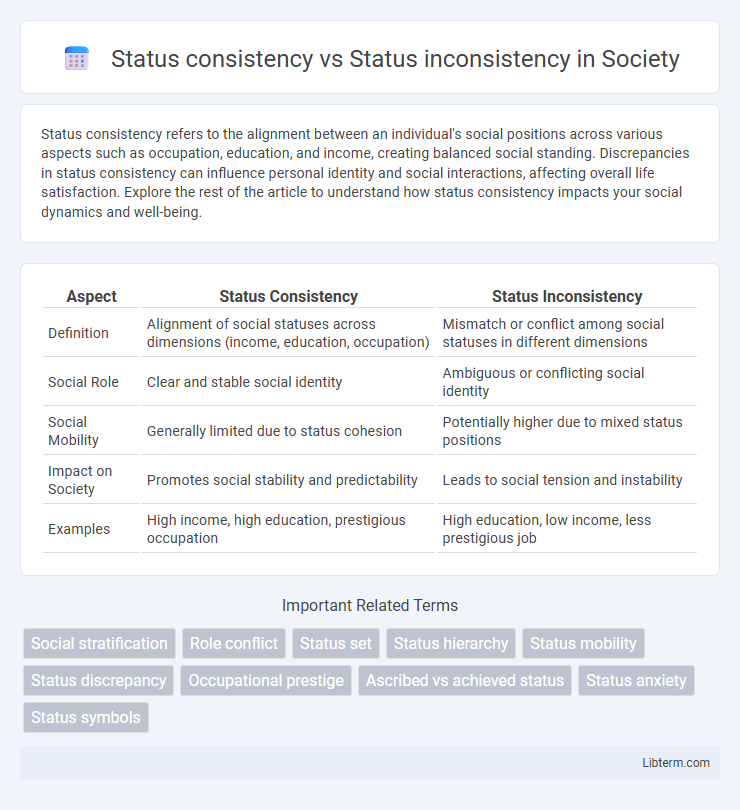Status consistency refers to the alignment between an individual's social positions across various aspects such as occupation, education, and income, creating balanced social standing. Discrepancies in status consistency can influence personal identity and social interactions, affecting overall life satisfaction. Explore the rest of the article to understand how status consistency impacts your social dynamics and well-being.
Table of Comparison
| Aspect | Status Consistency | Status Inconsistency |
|---|---|---|
| Definition | Alignment of social statuses across dimensions (income, education, occupation) | Mismatch or conflict among social statuses in different dimensions |
| Social Role | Clear and stable social identity | Ambiguous or conflicting social identity |
| Social Mobility | Generally limited due to status cohesion | Potentially higher due to mixed status positions |
| Impact on Society | Promotes social stability and predictability | Leads to social tension and instability |
| Examples | High income, high education, prestigious occupation | High education, low income, less prestigious job |
Understanding Status Consistency and Status Inconsistency
Status consistency occurs when an individual's social positions align across multiple status indicators, such as occupation, income, and education, resulting in harmonious social identity and predictability in social interactions. Status inconsistency arises when these social positions conflict, for example, a person with high education but low income, which can cause tension, social ambiguity, and challenges in role performance. Understanding these concepts is crucial for analyzing social behavior, stratification, and the psychological impact of conflicting social statuses on individuals.
Defining Key Concepts: Status, Consistency, and Inconsistency
Status refers to the social position or rank an individual holds within a group, shaped by factors like occupation, education, or wealth. Consistency occurs when an individual's statuses align smoothly without conflict, promoting social harmony and clear role expectations. Inconsistency arises when conflicting statuses produce tension or role strain, leading to social challenges and identity ambiguity.
Historical Background of Status Consistency Theory
Status consistency theory originated from sociological research in the mid-20th century, emphasizing how individuals maintain alignment across social statuses such as occupation, education, and income. Early studies by sociologists like Ralph H. Turner and William Thomas highlighted the social stability and predictability arising from consistent status positions within hierarchical structures. This foundational work contrasts with status inconsistency, where conflicting positions generate social tension and influence individual behavior and societal dynamics.
Causes of Status Inconsistency in Modern Societies
Status inconsistency arises in modern societies when individuals hold conflicting social positions across different status dimensions such as occupation, education, and income. Causes include rapid social mobility, educational attainment outpacing occupational reward, and structural changes in the labor market that decouple traditional status hierarchies. This inconsistency generates social tension as expectations and rewards from varied status roles do not align consistently.
Status Consistency: Effects on Social Mobility
Status consistency occurs when an individual's social positions across various dimensions, such as education, income, and occupation, align closely, reinforcing a stable social identity. This alignment facilitates smoother social mobility by providing coherent resources and opportunities that support upward or lateral movement within the social hierarchy. In contrast, status inconsistency can create barriers or tensions that complicate social advancement, but status consistency enhances predictability and access in social networks, significantly influencing positive social mobility outcomes.
Impact of Status Inconsistency on Individual Behavior
Status inconsistency occurs when an individual holds conflicting statuses, such as high education but low income, leading to psychological tension and social strain. This incongruence impacts individual behavior by increasing stress levels, fostering feelings of frustration, and motivating compensatory actions to resolve the dissonance. Research shows that status inconsistency can result in social withdrawal, aggressive behavior, or attempts to elevate one's perceived status through various means.
Social Consequences: Stability vs. Conflict
Status consistency fosters social stability by aligning an individual's rank across multiple dimensions such as wealth, education, and occupation, reducing role strain and promoting societal cohesion. In contrast, status inconsistency, where disparities exist between these statuses, often generates social tension and conflict due to conflicting expectations and perceived injustices. This discord can lead to individual dissatisfaction and broader group conflicts, challenging the equilibrium within social structures.
Status Inconsistency Across Cultures and Contexts
Status inconsistency occurs when an individual's social positions hold conflicting levels of prestige across different cultural or contextual settings, leading to varied social perceptions and interactions. For example, a professional recognized as high-status in their home country may face lower status in another culture due to different values or norms surrounding occupation or education. This disparity can result in social tension, identity conflict, and challenges in cross-cultural communication and integration.
Measuring Status Consistency: Indicators and Methodologies
Measuring status consistency involves evaluating the alignment between an individual's or group's socio-economic indicators such as income, education level, and occupational prestige. Common methodologies include status attainment models, which use statistical techniques like regression analysis to assess correlations among these variables, and composite indices that aggregate multiple status indicators for a comprehensive consistency score. Indicators such as occupational status scales (e.g., the Socioeconomic Index) and educational attainment categories provide quantifiable metrics essential for assessing the degree of status consistency or inconsistency within social hierarchies.
Addressing Status Inconsistency: Policy and Social Change
Addressing status inconsistency involves implementing targeted social policies that promote equity across economic, educational, and occupational domains to reduce disparities in social status. Policy frameworks emphasizing access to education, fair employment practices, and social support systems help mitigate the adverse effects of status inconsistency on individual well-being and social cohesion. Social change driven by inclusive legislation and community engagement fosters greater status alignment, enhancing social integration and reducing conflict arising from status disparities.
Status consistency Infographic

 libterm.com
libterm.com